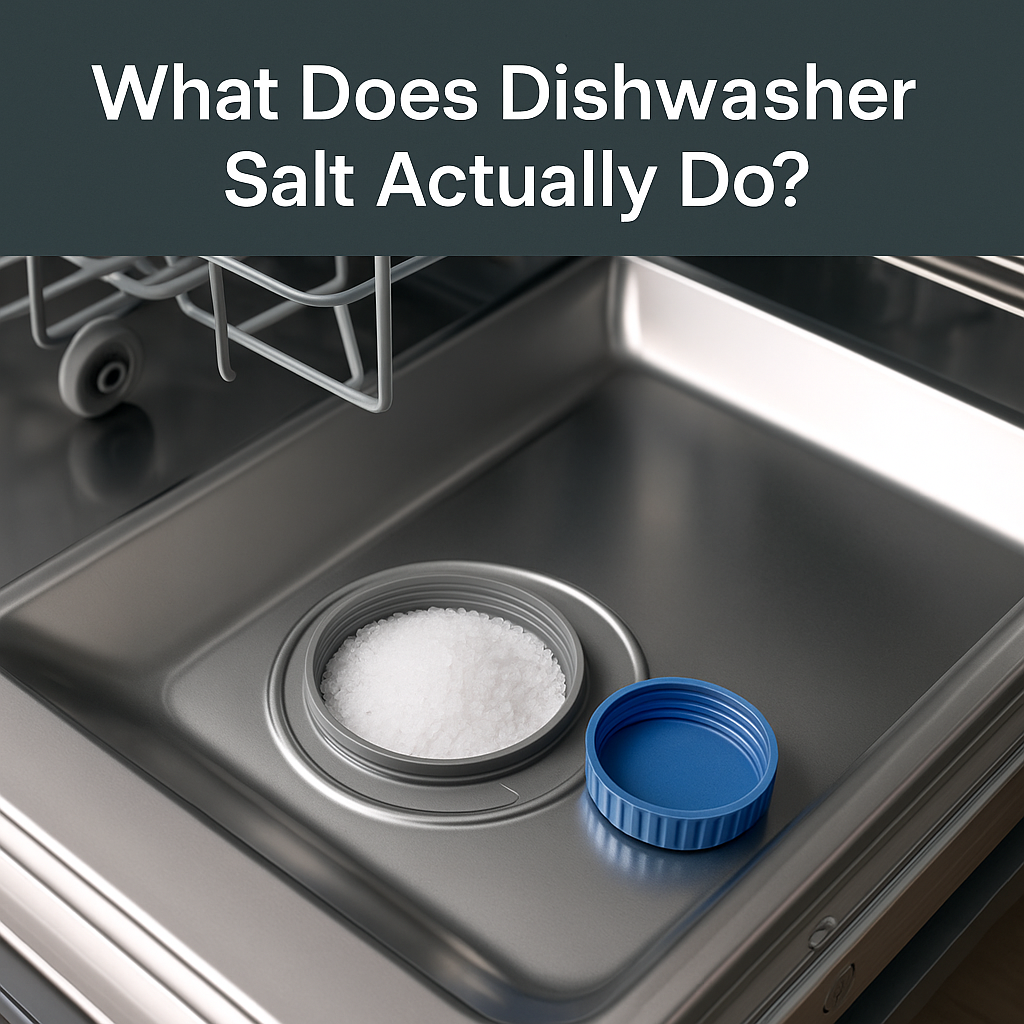When you hear “dishwasher salt,” it can sound unnecessary if you’re already using detergent and rinse aid. But in reality, dishwasher salt is the hidden key to keeping your dishes sparkling, your machine protected, and your water softener working as it should. Ignoring it might not show problems right away, but over months and years, it can damage your dishwasher and waste energy.
This guide covers everything from what dishwasher salt does to where to put it, how often to use it, why it’s different from table salt, and even little tricks that most people don’t know.
The Real Purpose of Dishwasher Salt
Dishwasher salt is not about adding flavour or disinfecting. Its main role is water softening. In many homes, tap water contains minerals like calcium and magnesium. These minerals cause “hard water,” which leaves limescale on heating elements and chalky residue on glassware.
Inside your dishwasher, there is a built-in water softener unit with resin beads. These beads grab calcium and magnesium ions but eventually lose their ability to trap more minerals. Dishwasher salt restores the beads by washing away the minerals and recharging them with sodium. Without this recharge, the water softener stops working, and you’ll notice cloudy glasses, film on dishes, and a gradual drop in cleaning power.
Why It Matters Even If Your Dishes Look Clean
At first, skipping dishwasher salt might not seem like a big deal. You might not notice spots or cloudy streaks right away, especially if you’re using strong detergent. But what happens behind the scenes is more damaging:
-
Limescale builds up on spray arms, making water flow weaker.
-
Heating elements get coated in calcium deposits, using more energy to heat the water.
-
Your dishwasher motor and pipes start to clog over time.
Think of it like plaque on teeth. You don’t notice serious pain in the beginning, but ignoring it eventually leads to big repair bills. Using dishwasher salt is preventive care for your machine.
Where to Put Dishwasher Salt
The salt doesn’t go into the detergent drawer. Most dishwashers have a separate compartment specifically for salt. It’s usually under the lower rack, with a cap you unscrew to fill.
When adding it:
-
Remove the bottom rack.
-
Open the salt reservoir cap.
-
Pour in dishwasher salt until it’s full. A small funnel helps avoid spills.
-
Wipe away loose grains because leftover salt at the base of the dishwasher can cause rust.
Some models have a light that tells you when it’s time to refill. If not, checking once every 3–4 weeks is a good habit.
Do I Need Dishwasher Salt If I Use All-in-One Tablets?
Many people rely on all-in-one or 3-in-1 tablets and assume extra salt isn’t necessary. But here’s what most guides don’t explain:
-
The salt inside tablets is very limited and dissolves quickly. It cannot regenerate the softener beads over many cycles.
-
Tablets work fine in soft-water regions but fail to protect against medium or hard water.
-
If you see white streaks on black plates or cloudy glass even with premium tablets, that’s a sign your dishwasher softener isn’t being recharged.
The safest approach is to always use dishwasher salt unless your water test proves your supply is very soft.
How Often You Actually Need to Refill It
Frequency depends on two things: water hardness and dishwasher usage.
-
In soft water areas, you might refill every 2–3 months.
-
In medium to hard water areas, once every 3–4 weeks is normal.
-
If you run your dishwasher twice a day, expect to refill more often.
A practical tip: run a simple water hardness test at home with strips or a kit. This way, you can adjust the dishwasher’s salt consumption setting to match your exact water type. Many people don’t know this setting exists, but it can save money by avoiding overuse of salt.
Can I Use Table Salt Instead?
This is one of the most common mistakes. Table salt, sea salt, and rock salt are not safe substitutes. They contain additives like anti-caking agents and iodine that can clog the softener compartment or scratch dishes.
Dishwasher salt is specially formulated to be coarse and pure sodium chloride. The larger grain size also ensures it dissolves slowly, providing a steady recharge to the water softener.
Extra Tips Most People Don’t Know
Here are some practical details that don’t usually show up in standard guides:
-
Adjust your dishwasher to your water hardness: Many models allow you to set the hardness level manually. If you don’t set it correctly, the machine may use too little or too much salt.
-
Salt and rinse aid are not the same thing: Salt softens water, while rinse aid reduces surface tension to stop droplets forming. Hard water areas often need both.
-
Always fill the salt compartment before a wash cycle: Spilled grains inside the tub can corrode stainless steel if they sit for too long.
-
Use a funnel: It prevents waste and keeps salt out of the dishwasher bottom.
-
Check local water reports: If you move houses, the water hardness may change, and so should your salt usage.
How Dishwasher Salt Saves Money Over Time
It might feel like an extra purchase, but dishwasher salt is one of the cheapest maintenance steps you can take. Without it, limescale forces your dishwasher to use more electricity, lowers detergent efficiency, and shortens the lifespan of parts like the heating coil. Repairs from hard water buildup can cost far more than years of dishwasher salt.
Wrapping Up
Dishwasher salt plays a bigger role than most people think. It keeps hard water under control, protects your machine, improves detergent efficiency, and gives you cleaner dishes with less effort. Skipping it often leads to hidden damage and higher running costs.
If you want to keep your dishwasher performing like new, always use the right salt, refill it on time, and adjust your machine settings for your water hardness.
For reliable dishwasher salt and other sustainable home decor, check out our full collection. Our quality products make it easier to take care of your appliances and keep your home running smoothly.








